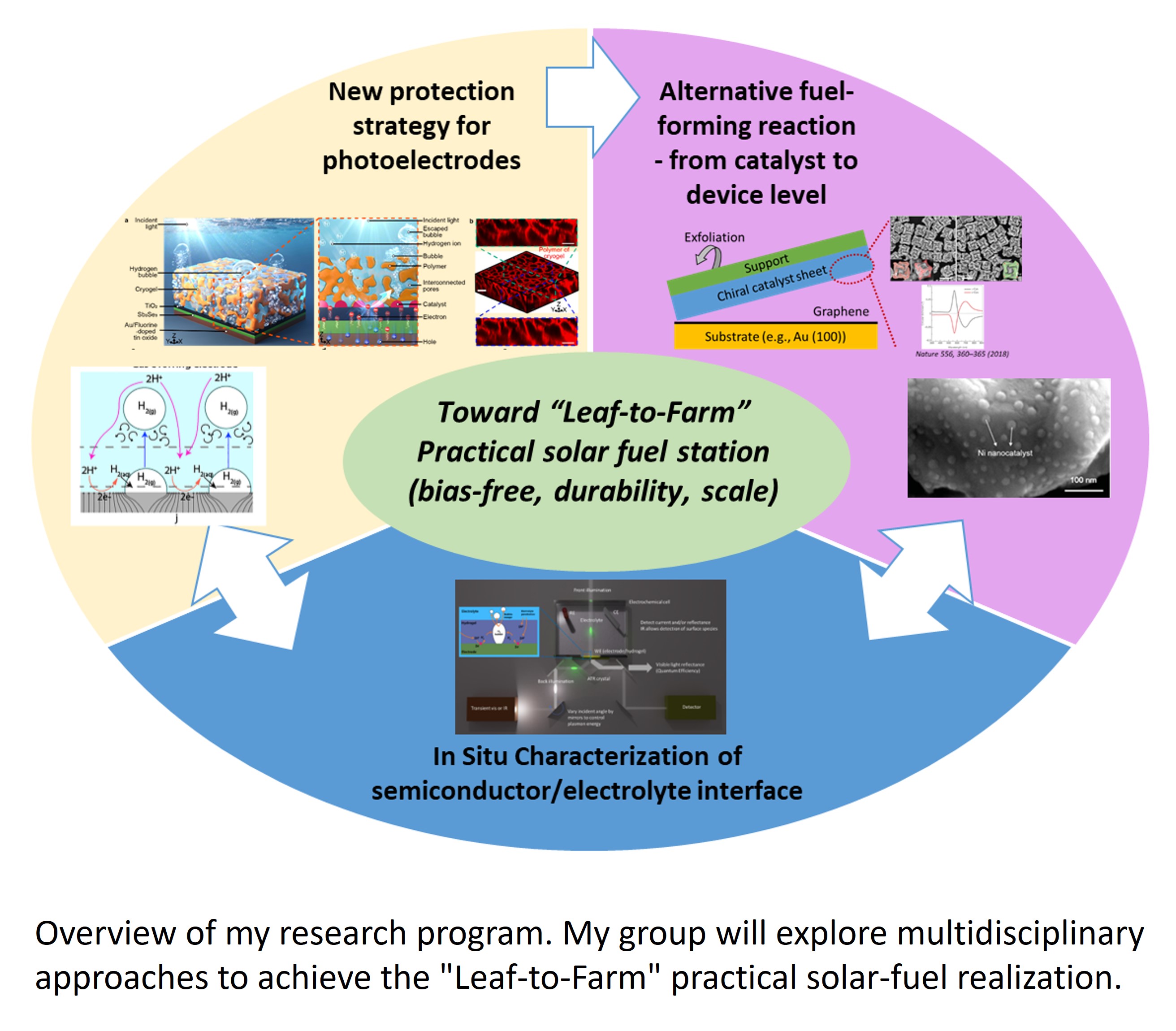(4t) Controlling Electrochemical CO2 Reduction Using Chirality-Induced Spin in Electrocatalysis
AIChE Annual Meeting
2024
2024 AIChE Annual Meeting
Meet the Candidates Poster Sessions
Meet the Faculty and Post-Doc Candidates Poster Session
Sunday, October 27, 2024 - 1:00pm to 3:00pm
1.1 Stable Green Hydrogen Production; Investigation of Protective Coating Material (correlation with Ph.D. research project)
“Green hydrogen†research constitutes a pivotal domain in achieving carbon neutrality worldwide, addressing the global climate crisis. Photoelectrochemical (PEC) water splitting is one promising green hydrogen technology which produces hydrogen using solar energy. Recent studies incorporating various photoelectrodes and tandem configurations have reported consecutive achievements in Solar-to-Hydrogen efficiency of 10-20% without external voltage. Despite high conversion efficiency, however, practical commercialization is hindered due to low stability of photoelectrodes, mainly the photo-corrosion of constituent materials and deterioration of surface catalysts. Addressing these limitations, we have successfully enhanced the stability of photoelectrodes by over 100 times by applying a hydrogel protector inspired by the surface structure of seaweed. Starting with a fundamental understanding of the protection mechanism of this hydrogel, my further research aims to validate its applicability across various devices and to elevate the durability of photoelectrodes to the commercial level. This study is a crucial step towards the broader implementation of stable and efficient green hydrogen production technologies.
1.2 Investigation of (Photo)electrochemical CO2 Reduction Catalysts; Materials and Devices (correlation with postdoctoral research project)
Another crucial technology for achieving carbon neutrality is fuel production through CO2 reduction. In contrast to water electrolysis, CO2 reduction results in various products, thus not only efficiency and stability but also precise control of selectivity is essential. Particularly, CO2 reduction reactions always compete with the hydrogen evolution reaction (HER), resulting in low carbon selectivity. To address this issue, I would apply the chirality-induced spin selectivity (CISS) phenomenon. In principle, utilizing the CISS allows spin alignment of charge carriers on the catalyst surface, inhibiting the formation of the singlet state according to Pauli's exclusion principle. Recent studies have successfully applied this principle to (photo)anodes, suppressing H2O2 formation and enhancing the efficiency and stability of the oxygen evolution reaction (OER). Applying this principle to the yet unexplored CO2 reduction (photo)cathode could fundamentally suppress the competing HER and maximize carbon selectivity. Due to the lack of understanding on the chirality transfer mechanism of chiral catalysts and a confirmed methodology for an enantiospecific electrodeposition, there is still a large area to be discovered in this research field. The goal is to precisely understand the mechanism and develop a benchmark methodology to impart chirality to catalysts regardless of materials.
1.3 Development of Bias-Free Solar Fuel Station (Long-term goal)
The ultimate goal is to contribute substantively to carbon neutrality. Leveraging the technological advancements gained through short to medium-term research on materials and devices, I aim to establish a large-scale station for Solar-to-Fuel conversion under bias-free conditions. Collaboration with experienced experts is crucial throughout this process, and I am confident that UNIST is the most suitable institution to achieve this goal.
Teaching Interests
Teaching and mentoring have always been a great joy for me, and I am excited about the prospect of a career that involves teaching at different levels. Philosophically, I believe that a combination of ease, fun, and interest leads to the best classroom teaching and learning environment. Students should find the coursework approachable yet challenging and be inspired to put in significant effort by understanding its real-world significance. By using examples, demonstrations, and hands-on experiences, I aim to keep students engaged and excited. Additionally, I believe in being open and available to support students, especially undergraduates, throughout the learning process.
During my academic career, I have consistently excelled in both fundamental and advanced courses, positioning me well to teach a wide range of subjects in Chemical Engineering. At the undergraduate level, I can effectively teach fundamental courses such as Thermodynamics and Solid State Chemistry, providing students with a strong base in these essential subjects. In advanced courses, I aim to delve deeper into specialized topics, ensuring students gain comprehensive knowledge and advanced skills. As my expertise particularly shines in Electrochemistry, I can offer courses such as Advanced Electrochemistry including the Electrochemical Impedance Spectroscopy and Photoelectrochemistry. I am also enthusiastic about offering specialized courses that align with my research interests, such as Solar Fuels and Hydrogen Society. These courses will be designed to convey theoretical knowledge while providing practical insights and applications relevant to current research and industry trends.
By integrating my extensive academic background and research experience, I strive to create an engaging and intellectually stimulating learning environment. My goal is to inspire and equip students with the knowledge and skills necessary to excel in their academic and professional pursuits in chemical engineering.
Checkout
This paper has an Extended Abstract file available; you must purchase the conference proceedings to access it.
Do you already own this?
Log In for instructions on accessing this content.
Pricing
Individuals
| AIChE Pro Members | $150.00 |
| AIChE Emeritus Members | $105.00 |
| AIChE Graduate Student Members | Free |
| AIChE Undergraduate Student Members | Free |
| AIChE Explorer Members | $225.00 |
| Non-Members | $225.00 |
